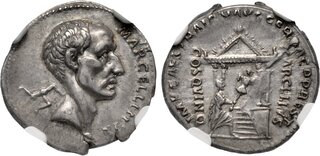| Classical Numismatic Group > Triton XXVII | Auction date: 9 January 2024 |
| Lot number: 751 Price realized: 18,000 USD (Approx. 16,486 EUR) Note: Prices do not include buyer's fees. | Show similar lots on CoinArchives Find similar lots in upcoming auctions on |
| Lot description: Trajan. AD 98-117. AR Denarius (19mm, 3.47 g, 6h). Restored issue of M. Claudius Marcellus. Rome. Struck circa AD 107 or 112/113. MARCELLINVS downward to right, bare head of the consul M. Claudius Marcellus right; triskeles to left / IMP CAES TRAIAN AVG GER DAC P P REST around, MARCELLVS downward in field to right, COS QVINQ downward in field to left, M. Claudius Marcellus advancing right, carrying trophy held in right hand into tetrastyle temple. RIC II 809 (same dies as illustration); Woytek 8342 (this coin referenced and illustrated); H. Mattingly, "The Restored Coins of Trajan" in NC 1926, 35, pl. XII, 16 (same dies); Komnick Type 36.0, 2 (V1/R2); RSC 35 (same dies as illustration); BMCRE 689 (same dies); BN 502 (same obv. die): cf. Crawford 439/1 (for prototype); cf. Sydenham 1147 (same); cf. Claudia 11 (same). Cabinet toned. In NGC encapsulation 2130990-002, graded AU★, Strike: 5/5, Surface: 4/5, Fine Style. Ex Classical Numismatic Group 114 (13 May 2020), lot 842; Palombo 17 (20 October 2018), lot 61; Numismatica Ars Classica 33 (6 April 2006), lot 479. This exceedingly rare coin, struck under Trajan, copies a denarius of 50 BC issued by the moneyer P. Cornelius Lentulus Marcellinus (ref. Crawford 439/1). The obverse shows the head of the general M. Claudius Marcellus, consul five times, with a triskeles behind that reminds of his conquest of Syracuse in 211 BC during the second Punic War. The reverse shows the moneyer's ancestor, carrying a Gallic trophy into the tetrastyle temple of Jupiter Feretrius (supposedly the first temple to have been built in Rome), which commemorates his victory of 222 BC against the Celtic Insubres under their king Britomartis. Curtis Clay wrote, the primary purpose of restored coins was to provide substitutes in circulation for coin types that had become familiar, but that the emperor was calling in, melting down, and restriking, because the originals were worn out and sometimes also because they contained more precious metal than current coins, so the emperor could make a profit. When selecting the types for the restored coins, however, a secondary purpose kicked in: to present a full picture of earlier Roman coinage, and to honor worthy earlier emperors, even if the earlier coins in question were not actually being called in and restruck, either because they were so old that they were no longer in circulation, or because they were so recent that they were still in excellent condition and contained no more bullion than the mint's current production. This secondary purpose explains Trajan's restoration of both a Republican didrachm, though such didrachms were certainly no longer in circulation, and of aurei of Nerva and Divus Nerva, though Nerva's aurei were only a decade old so didn't need restriking because of wear. It explains why Trajan Decius' restored antoniniani included coins for Divus Augustus, whose original denarii had long since disappeared from circulation. And finally it explains why Titus' restored bronzes included coins for Galba, whose original bronzes were also only a dozen years old. As Mattingly wrote regarding Titus' selection of emperors for restoration: "The list of persons whose coins were to be restored was evidently drawn up with deliberate care. Tiberius, Claudius, and Galba were included, Caligula, Nero, Otho, and Vitellius omitted. The list is something like a roll of honour of the early Empire, preserving all memories that deserved to be remembered" (BMC II, p. lxxviii). Relative to dating Trajan's restored coins, the traditional dating of AD 107 is based on Eckhel's theory linking the restitution coinage with the general recoinage that Dio places after Trajan's return from the Second Dacian War. Bernhard Woytek disagrees, and places their issue in AD 112/113, surmising that the appearance of Divus Nerva in this coinage must be contemporary to his appearance on an aureus securely dated to that period. Clay, however, pleads for the traditional dating of recoinage which, according to Dio, began circa AD 107. Curtis states that "If the restored coinage was connected with the recoinage, and the recoinage began circa AD 107, how likely is it that Trajan would have waited until AD 112-3 to issue the restored coins resulting from that recoinage?" Estimate: 15000 USD |  |



